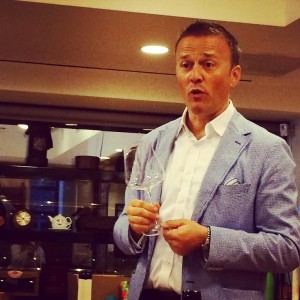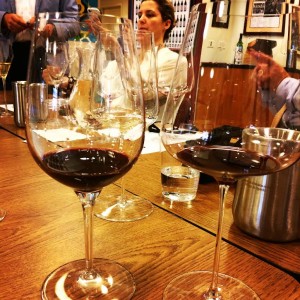Last Wednesday, July 9th, the great Chef Sommelier of Le Bernardin in New York City, Aldo Sohm, came to our store to give us a staff training on some of his products that we will be carrying. Don’t worry, I’m not going to try to sell you anything. This is my personal blog, and I write about things involving wine that interest me. First of all, Aldo Sohm has a wonderful personality. He has a true gift for making people feel at ease, and I think that is a mark of a great sommelier. He went through a presentation of his cork screw, the Grüner Veltliner wine project he has with the Kracher family, and the glasses that he is bringing into New York City made by Zalto in Austria. These glasses were obviously imperfect, hand blown and not perfectly symmetrical. I have been thinking of them ever since that training, and the idea of how imperfection is beautiful.
The University of Tennessee conducted a study in 2002 that found that the shape of a glass can have a big influence on chemicals in wine that affect taste. The study involved a Merlot wine that sat in three different glasses: a flute glass, a Martini glass and a wide Bordeaux glass. The study showed that between 10 to 20 minutes later the phenolic compound called gallic acid had decreased in the Bordeaux glass. This has to do with more surface area exposed to oxygen and all that kind of good stuff. Most of us already know this fact, bigger glass= more oxygen, which is desired for some wines but not for others. But does the shape of the glass, particularly to the degree of whether the shape is symmetrical or non-symmetrical, alter the wine in any other way?
Many years ago I met a great Japanese tea master in New York City. He taught me about the idea of Wabi-sabi, which is a Japanese aesthetic theory that is based on the acceptance of imperfection. This was best represented in his view by the art of making Japanese tea bowls. The tea bowls that have the most evident imperfections are celebrated and considered the most valuable. Wabi-sabi has three simple principles:
-nothing lasts
-nothing is finished
-nothing is perfect
Looking at these Zalto wine glasses I could not help but think of the above lesson. I thought about other past experiences celebrating imperfection. Many years ago I taught yoga on the side, and actually specialized in teaching yoga to people who suffered from serious accidents or were living with dis-ease. Why did I feel the need to volunteer to teach classes that many people thought were depressing to teach? Well, many people go to therapy to deal with their personal issues… this was my therapy.
When I was teaching those yoga classes I met people who had lost their arms or legs and/or had large humps on their bodies, and my initial feeling was to feel sorry for them. But through time, I realized these people were extraordinary, and they may have been living with a physical handicap or dis-ease, but they were more at ease than I was. And through time I realized that I was not there to teach them to see that their imperfections were beautiful, they were there to teach me that lesson. It has taken me years to truly understand that lesson, and I really feel like I am just starting to learn it.
I am sorry to jump from something so serious to something seemingly superficial, but I remember also learning this lesson when someone I knew interned at a Howard Stern event around 18 years ago. I was 21 at the time, and the young man interning was probably just a few years older. He was very excited because there were going to be tons of Playboy women that he would have a chance to “help” change. When I saw him after the event, I asked him how it went, and surprisingly, he said he was disappointed. He said the Playboy women looked so perfect that there was nothing exciting about seeing them naked. It was like looking at a doll. He had a renewed appreciation of how exciting it was to see the “imperfections” of his girlfriend’s body. Now please, don’t take me the wrong way, I have nothing against plastic surgery, and I have a philosophy that people should do what makes them happy. I am very supportive of any friend that makes that choice, even though I may think they do not need it.
Back to these Zalto glasses. Yes, I did see a difference in these glasses next to a control glass that was perfect in shape, especially when comparing them. I was getting more complexity on the nose and palate from the wines in the Zalto glasses. I have to note the glasses are some of the lightest I have ever picked up, and that quality made me take more time with the wines. Also, the imperfection in their shape made me stop and take more notice of the wines as well. And I felt I was having a wine that was out of the ordinary, because it was such a different experience holding and looking at those glasses.
As I get older, I like the imperfections of my face more and more.
One side of my nose is slightly bigger than the other, my ears are completely different from each other, I get more freckles, moles, wrinkles as time goes by, etc, etc… And the picture above is not the “worst” I could take… a week before the Masters of Wine exam, I broke out with acne so much it was scary! All of my imperfections make me unique and tell a story of my life, and I’m proud of them.
I like wines, people, and glasses that tell a story that is unique and rare. As Aldo said about the Zalto glasses, “No two glasses are the same.” And he celebrated the idea that those glasses were imperfect, and it was a great reminder, that I should celebrate what is imperfect about me too.














